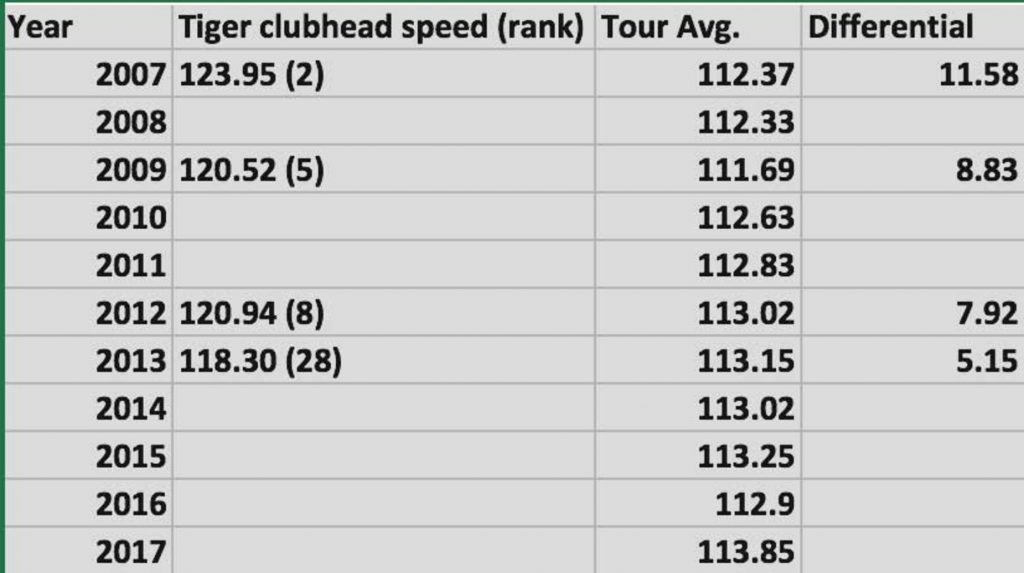As we ready for Tiger Woods’ return (again) to competitive golf, it is not an outrageous assumption that injury and time have robbed Woods of some clubhead speed. After all, Woods’ last full season in 2013 saw him average 118.3 miles per hour. In limited play in 2017, it was down to 113.85mph, a number he is more likely to return at. That equates to a distance loss of some eight to 10 yards, begging the question: How can Tiger keep up?
For starters, it’s not that 114mph is slow. In fact, it’s the tour average. But 10 yards is 10 yards. Fortunately for Woods he has one thing going for him in his quest to regain any loss of distance: He’s a very inefficient driver of the golf ball.
Despite the endless hours pros spend getting “dialled in” to their equipment, not all players have reached their maximum efficiency off the tee, and Woods is a prime example.

Although hardly a measure of how good a driver of the ball a player is, distance efficiency does indicate whether you’re getting the most out of your swing off the tee – and during his career Woods has not. From 2007 (when the stat first became available) through 2013 (his last full season), Woods’ rank in distance efficiency was 138th, 125th, 171st and 172nd. He did not play enough to officially qualify for a ranking in 2008, 2010 and 2011. So, how does Woods get better and, more importantly, how much better can he get?
To max out distance off the tee players need the absolute best match with their driver, golf ball and launch conditions. What is the key to efficiency? Almost without exception it is a combination of high launch with low spin.
Woods’ numbers speak to the importance of the launch angle/spin connection. In 2007 ,Woods was the epitome of a player whose launch conditions off the tee were the worst of both worlds as he combined a low launch (8.45 degrees) with high spin (3,343 rpm). In 2013, Woods had a more desirable launch condition of 11.20 degrees launch angle and a spin rate of 2,513 rpm. Still, that’s a bit from ideal.
Making Progress pic.twitter.com/I3MZhJ74kI
— Tiger Woods (@TigerWoods) October 15, 2017
Woods’ distance efficiency that year was 2.503 – meaning he got that many yards per mile per hour of clubhead speed. However since the stat was introduced in 2007, the leader in the category has averaged 2.690 yards per mile per hour. Let’s assume Woods comes back swinging at 114mph (183kph). At the 2.503 number that’s a driving distance of 285.3 yards. However at 2.690 that would increase to 306.7 yards. Those numbers are not fantasy land, either. Last year Shane Lowry had an average clubhead speed of 114.6mph. and a distance efficiency number of 2.660. That put him at 304.6 yards off the tee.
Woods doesn’t even have to reach the extreme to improve. Using a trajectory model developed by the University of Waterloo outside Toronto, if he bumped his launch angle up to 12.5 degrees and lowered his spin to 2,300 rpms, his distance would be at 299.5 yards with a modern ball. Woods, of course, would need to make some adjustments in swing and equipment to achieve that. A lower-spinning driver could help (Woods last used a TaylorMade M2 driver – a club with no movable weights—and perhaps fiddling with a club with adjustable weights would work), but trying to correct low launch and high spin through driver only is a tough chore.
Which means Woods might have to make some other changes as well. He has long said that he wants a ball to spin as much as possible and it’s his job to take the spin off. For max distance efficiency, however, a lower-spinning ball (Woods last was seen using Bridgestone’s Tour B330-S – the spinniest of the company’s tour models at the time) would seem to be a good call. Swing adjustments also would likely need to be made as would Woods’ penchant for teeing it lower than most pros.
Of course, as with all equipment decisions, a player needs to find the right balance for their entire game, not just the tee ball. It should be interesting to see the choices Woods will make not only as he returns to competitive golf, but tries to be competitive.




